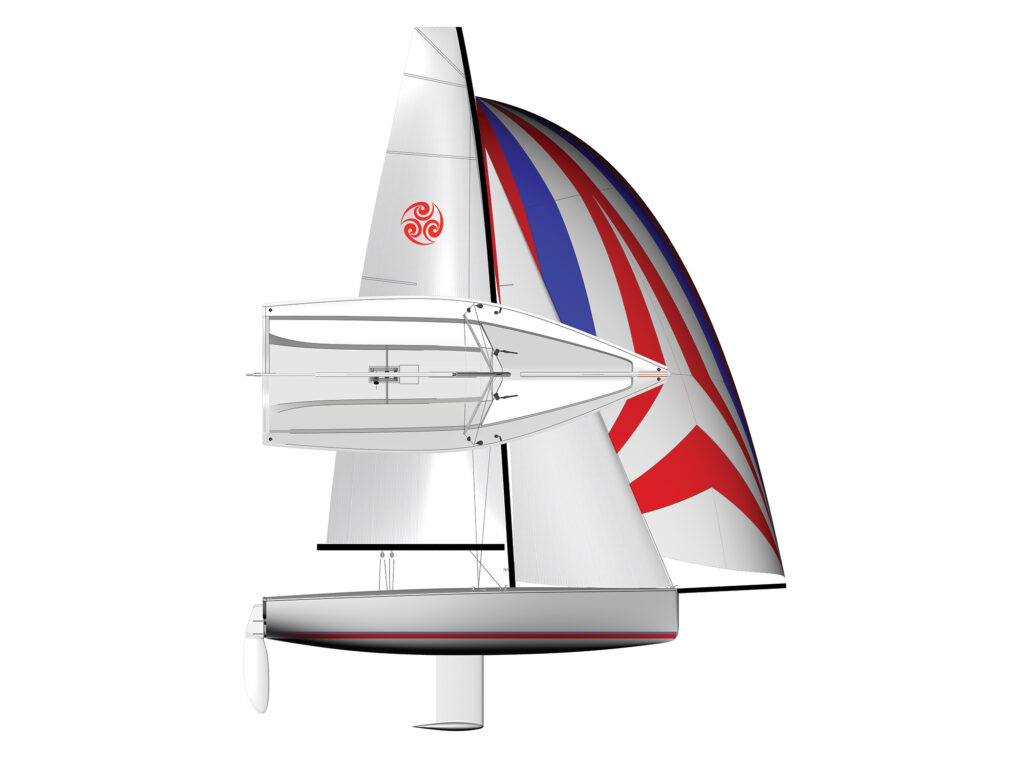
As boat-ownership costs and accessibility continue to stymie the sport, many American sailors and newcomers now depend on yacht clubs, community sailing centers, and sailing schools to get on the water and racing. As a result, institutions that can afford to do so are now looking into club-owned fleets that can be used for adult racing and instruction. Their options are limited, but the founders of Storm Marine, a new company, say that they have the “ideal” offering.
Several East Coast clubs with deeper pockets and team-racing programs have recently invested in Sonars, the utilitarian design of the late Bruce Kirby, but these boats are now imported from England and are either cost-prohibitive or too large for most organizations. Storm Marine’s offering instead is a utilitarian keelboat that they say is designed to serve and built to last.
“Sailing is in a bit of a decline,” says Karl Ziegler, a world champion of multiple disciplines and co-founder of Storm Marine, “and yacht clubs are struggling to maintain their membership, particularly young members. A lot of the new members are coming from a couple of different demographics who are not in a position to buy boats to sail. They just want to join a club and be able to sail boats at that club.”
What’s now used at most clubs, Ziegler says, are boats that are either outdated in their design and construction, no longer in production, and difficult to maintain and source parts. “That means an increased burden on the maintenance staff, and quite honestly, they don’t provide that ‘wow’ experience for the new member who is sailing for the first time.”
The solution that Ziegler and his cohorts in New England have come up with is called the Storm 18, which will be built by David Clark’s Fulcrum Speedworks, creator of the UFO, a pint-size foiling catamaran, and the Rocket, a redo of the Howmar Phantom, a 14-foot dinghy of the 1970s.
One of Ziegler’s partners in the venture is William Craine, who’s been in the boatbuilding industry for decades, most recently with LaserPerformance. Craine’s yacht club on Long Island Sound is looking to replace its ancient fleet of Ideal 18s, another Bruce Kirby design. Certain traits of the Ideal 18 and the Sonar are carried into the Storm 18, which is designed by naval architect Bob Ames.
“We looked at a lot of things Bruce did, particularly the cockpit, and then we tried to make it more contemporary,” Craine says. “This is an evolutionary boat. It’s pretty hard not to be these days, unless you’re foiling or doing something crazy. [The Storm 18] is reminiscent of an Ideal 18 on purpose—because it works.”
Craine, Ziegler and Storm’s third co-founder, Chris Daley, did their due diligence before pushing ahead with a new boat, and that included a deep analysis of other designs, canvassing clubs and sailing schools, and picking the brains of experienced program directors and industry experts the likes of Hall of Famer and sailmaker Robbie Doyle. The common demand across all institutions was durability. “That means fewer parts, an infusion build, and a rub rail all the way around,” Craine says. “Clubs that do a lot of team racing and learn-to-sail programs want bow and stern bumpers, so those are standard.”
Stability and safety were next, Ziegler says, so the rudder is oversize. The cockpit is deep and has the option for newbies to sit inside the gunwale or racers on the rail. The conceptual sail plan—with a square-top main, a small hanked-on jib, and asymmetric spinnaker (symmetric is an option for match- or team-racing programs)—is designed with light-air venues and beginners in mind. “It’s a pretty generic design,” Craine admits, “but all together, it is something different.”
For institutions with limited storage space and infrastructure, there’s a retractable keel, a custom cradle in design, and a swing-up rudder to allow ramp launching where hoists are not available. The target price, Craine says, is $40,000, but larger fleet purchases always garner a better deal.
As of early 2024, tooling was underway at Fulcrum’s facility in East Providence, Rhode Island, and Storm Marine’s plan is to sail the prototype through late spring before stepping off into full production over late summer or early fall, a moment that for Ziegler, can’t come soon enough.
“This entire project has been a labor of love,” he says. “It’s an opportunity to fill a space that we’ve seen open for a number of years. It’s not a sexy space, but it’s a space of utility and a space where we see an opportunity to impact the overall growth of the sport. We’ve all been the beneficiaries of institutional sailboats, and we just wanted to be part of a project where we could give that experience to the next generation of sailors.”









